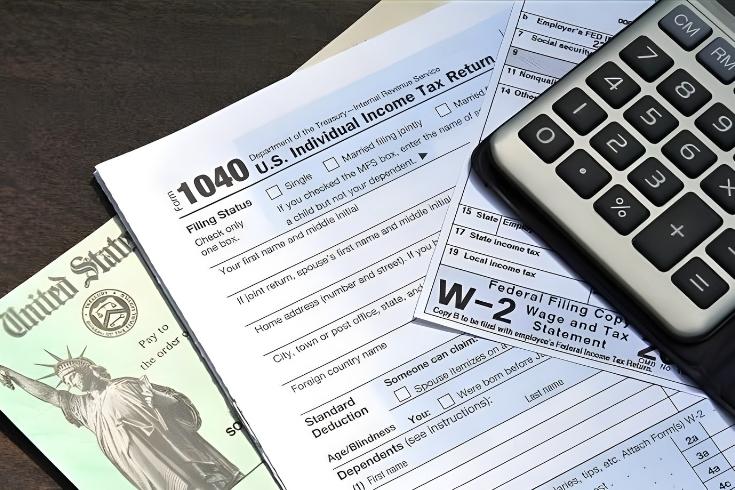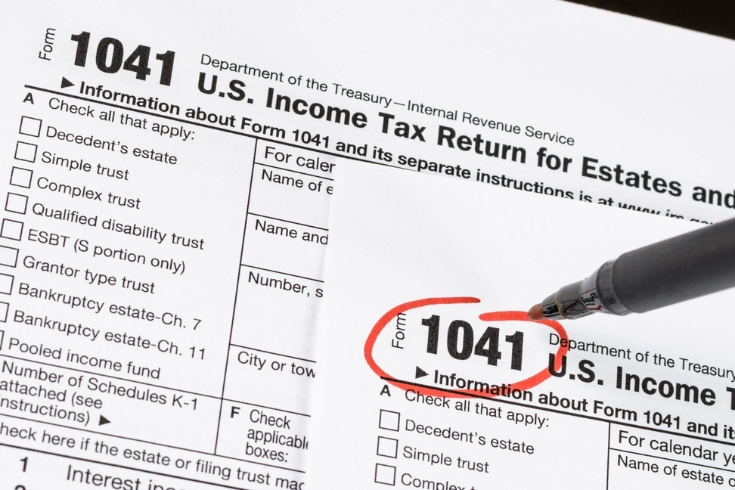Plan Smarter. Grow Stronger. Don’t miss our latest financial strategies.
November 13, 2025
Everything You Need to Know About 1040 Series Tax Returns
✅ Information Verified By a CPA

The 1040 series is the foundation of individual income tax filing in the United States. Every taxpayer who earns income, whether from a job, self-employment, or investments, must use one of these forms to report income, claim deductions and credits, and determine their total tax liability or refund.
Understanding which version of Form 1040 applies to your situation helps ensure accurate filing, compliance with IRS rules, and the avoidance of costly errors. Filing correctly also ensures you pay only what you owe and can claim all the tax benefits available to you.
The Different Form 1040 Versions
The IRS offers several 1040 variations to accommodate different taxpayer categories. Selecting the correct one ensures compliance and simplifies the filing process.
Form 1040 - The Standard
Most U.S. taxpayers use the standard Form 1040. It reports income, calculates tax, and applies deductions and credits.
Form 1040 SR - For Seniors
Made for taxpayers aged 65 and older, this version has larger text and includes a standard deduction chart for easier reading.
Form 1040-NR - For Non-residents Aliens
Non-resident individuals who earn U.S. income use this form to meet their federal tax obligations.
Form 1040-X – Amending a Tax Return
If you discover a mistake on a previously filed return, use Form 1040-X to make corrections.
Form 1040-ES – Estimated Taxes
Individuals with income not subject to withholding, like freelancers or investors, use Form 1040-ES to pay estimated taxes throughout the year.
Key Tax Concepts and Terminology
Understanding a few key terms makes filing easier. Here’s a simple breakdown:
Gross Income vs. Taxable Income
Gross income is all the money you earn in a year, including wages, freelance income, rental income, dividends, or interest. Taxable income is the portion the IRS taxes after deductions and exemptions.
Let’s say you earn $75,000 in total during the year, this includes your salary and some freelance income.
You then claim:
- $13,850 as the standard deduction (for a single filer in2024)
- $1,150 in deductible student loan interest.
Your taxable income would be:
$75,000 − ($13,850 + $1,150) = $60,000
So, while your gross income is $75,000, you’ll only pay federal income tax on $60,000.
Filing Status
Your filing status affects your tax rates and eligibility for credits. The five main statuses are Single, Married Filing Jointly, Married Filing Separately, Head of Household, and Qualifying Widow(er).
Standard vs. Itemized Deductions
The standard deduction is a fixed amount set by the IRS based on your filing status. Itemized deductions, on the other hand, allow you to list out specific deductible expenses, such as medical bills, mortgage interest, state and local taxes, or charitable donations, instead of taking the flat standard deduction. However, many of these deductions are subject to limitations or income thresholds.
For example, if your total itemized deductions add up to $14,000,and the standard deduction for your filing status is $13,850, you will choose to itemize because it reduces your taxable income by an extra $150.
However, if your itemized deductions were less than $13,850, it would make more sense to take the standard deduction, since it gives you a larger reduction automatically.
Tax Credits vs. Tax Deductions
Deductions reduce the amount of income that is subject to tax, while credits directly reduce the amount of tax you owe.
For example, if your taxable income is $50,000 and you claim a $2,000deduction, your taxable income drops to $48,000. But if you qualify for a $1,000 tax credit, your total tax bill is reduced by $1,000,dollar for dollar.
Common tax credits include:
- The Child Tax Credit (for eligible parents or guardians)
- The Earned Income Tax Credit (EITC) (for low- to moderate-income workers)
- Education credits, such as the American Opportunity Credit or Lifetime Learning Credit
Understanding which deductions and credits apply to your situation can significantly lower your tax liability, and, in some cases, even increase your refund.
Adjusted Gross Income (AGI)
AGI is your total income minus certain “above-the-line” deductions, such as contributions to a traditional IRA, student loan interest, or health savings accounts contributions. Your AGI matters because many tax benefits, including credits and additional deductions, are limited.
Taxable Events and Income Sources
Not all income comes from a regular paycheck. The IRS requires you to report most types of earnings, even if they don’t seem like traditional income. This includes:
- Freelance and gig income (from platforms like Uber, Etsy, or Upwork)
- Rental income from property you own
- Capital gains from selling stocks or other investments
- Interest and dividends from savings or investments
- Prizes, awards, or gifts — some of which may be taxable depending on their source and amount
Understanding Withholding and Estimated Taxes
If you’re an employee, your employer typically withholds taxes from each pay check and sends them to the IRS on your behalf. This covers your income tax, Social Security, and Medicare contributions.
However, if you’re self-employed, have multiple income sources, or earn income without withholding, such as freelance or investment income, you’re responsible for making quarterly estimated tax payments.
Paying the correct amount throughout the year is essential to:
- Avoid under payment penalties
- Prevent an unexpected large tax bill when you file your return.
The IRS provides Form 1040-ES to help taxpayers calculate and submit estimated payments accurately.
The Filing Process
Filing your taxes doesn’t have to feel like a burden. Breaking it down step by step to make the process much easier to manage.
Gather Required Documents
Start by pulling together all the paperwork you’ll need. This includes W-2 forms from employers, 1099 forms for freelance or investment income, mortgage interest statements, and any receipts for deductions. Having everything organized ahead of time saves you from last-minute mess and ensures you don’t miss any deductions or credits you qualify for.
Key Dates
Most 1040 tax returns are due on April 15. If that falls on a weekend or holiday, he IRS moves the deadline to the next business day. If you need extra time, you can request a six-month filing extension. You need to remember that an extension only gives you more time to file, it doesn’t delay any taxes you owe. Keeping these dates in mind helps you avoid penalties.
Filing Options
You can file taxes in different ways. E-filing with tax software is fast and gives instant confirmation that your return was received. Using a tax professional is helpful if your finances are complex or if you want to make sure you claim every deduction. Paper filing is still an option, though it takes longer for the IRS to process. Pick the method that works best for your situation and comfort level. Sproutax is a trusted CPA firm that helps their clients undergo smooth tax filing process.
5 Common situations for 1040 Tax Return
Filing taxes can be annoying when you have multiple income sources or have no knowledge around financial sector. Knowing the common tax situations helps you stay organized and avoid mistakes on your 1040.
Self-Employment Tax
If you are self-employed or a freelancer, or run a small business, you are responsible for paying Social Security and Medicare taxes yourself. This is called self-employment tax. Unlike employees whose taxes are withheld from paychecks, you need to calculate them based on your net earnings. Keeping clear records of income and business expenses makes it easier to pay the correct amount.
Tax Refunds and Penalties
If you pay more tax than you owe during the year, the IRS will refund the extra amount. If you pay too little, you may face penalties and interest. Missing the filing deadline or underpaying estimated taxes can trigger these charges. To avoid them, make timely payments or adjust withholding so the right amount is paid throughout the year.
Income from Different Sources
Some people have multiple income sources, such as wages, freelance work, or investment income. Each type needs to be reported correctly on Form 1040. Using documents like W-2s and 1099s for each source ensures that everything is accurate and reduces the chance of mistakes.
Claiming Dependents and Tax Credits
Claiming dependents can lower the amount of tax you owe. This includes children or other family members you support. By claiming them, you qualify for tax credits like the Child Tax Credit or Earned Income Credit. Keep good records of who qualifies and their details to make sure you claim the right credits and reduce your tax bill.
Tax Deductions
Deductions reduce the amount of income you pay tax on. Common deductions include mortgage interest, student loan interest, and business expenses. You can choose the standard deduction or itemize your deductions. Picking the option that lowers your tax the most will save you money.
Knowing how to handle self-employment tax, multiple income sources, dependents, and deductions can make filing easier. It also helps reduce penalties and maximize any refund you may get.
Conclusion
Filing becomes manageable when you understand the 1040 tax returnseries and its purpose. Knowing which forms to use, tracking deductions, and claiming eligible credits helps ensure accurate reporting and prevents costly errors.
Staying organized and informed allows you to make better financial decisions. For those with complex income or unique tax situations, consulting a qualified tax professional provides clarity, confidence, and the best chance to optimize your return.
Book a consultation with Sproutax today to get expert guidance tailored to your 1040 filing needs.
FAQs
What if I made a mistake on a return I already filed?
If you notice an error, you can file Form 1040X to correct it. Common mistakes include incorrect income, missed deductions, or filing status errors. Filing an amended return helps avoid penalties and ensures your tax record is accurate.
Can I get an extension to file my tax return?
Yes, you can request an extension using Form 4868. You can request an automatic six-month filing extension by submitting Form 4868 to the IRS. This extends your filing deadline, usually until October 15. However, the extension only applies to filing, tax payments are still due by April 15,and unpaid balances may accrue interest or penalties.
What Does It Mean to Get a Tax Refund?
A tax refund occurs when you’ve paid more in taxes throughout the year than your actual tax liability. This can happen if too much was withheld from your paycheck or if your estimated tax payments exceeded what you owed. In that case, the IRS refunds the difference, either by direct deposit or paper check, once your return is processed.
How can I pay my taxes?
You can pay your taxes through direct debit, credit or debit card, check, or by using the IRS’s online payment portal. If you make estimated tax payments, you can schedule them quarterly using Form 1040-ES. Paying on time and using secure methods helps you avoid penalties and interest charges.











.svg)
.svg)